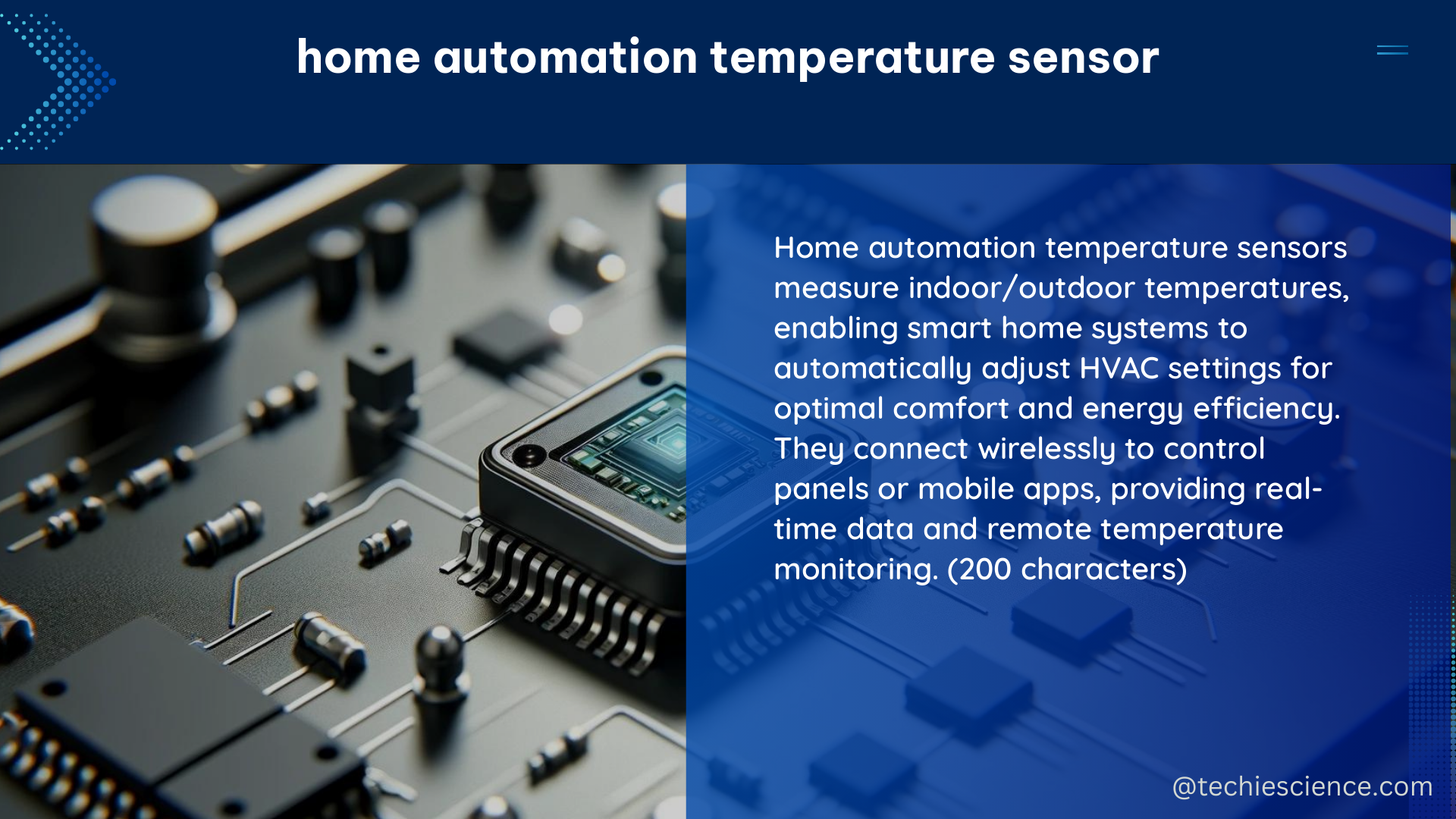Home automation temperature sensors are an essential component of smart homes, providing quantifiable data on temperature and humidity levels within the home. These sensors can be integrated with home automation systems to regulate and monitor temperature, enhancing convenience, safety, and improving the quality of life for home occupants.
Understanding Home Automation Temperature Sensors
Home automation temperature sensors are designed to measure and report the temperature and humidity levels within a specific area of a home. These sensors can be connected to a home automation system, allowing for remote monitoring and control of the home’s climate.
Sensor Specifications
When selecting temperature sensors for home automation systems, it is essential to consider the following sensor specifications:
- Operating Voltage: The voltage range the sensor can operate within, typically ranging from 1.8V to 3.3V DC.
- Pressure Range: The atmospheric pressure range the sensor can measure, typically from 300 to 1100 hPa.
- Temperature Range: The temperature range the sensor can measure, typically from -40°C to 85°C (-40°F to 185°F).
- Temperature Resolution: The smallest temperature change the sensor can detect, typically 0.1°C or 0.18°F.
- Temperature Accuracy: The maximum deviation from the actual temperature, typically within ±1°C or ±1.8°F.
- Relative Humidity Range: The range of humidity levels the sensor can measure, typically from 0% to 100%.
- Relative Humidity Accuracy: The maximum deviation from the actual humidity level, typically within ±3%.
- Power Consumption: The amount of power the sensor requires to operate, typically in the range of 1-10 mW.
Sensor Technologies
Home automation temperature sensors can be connected to home automation systems using various technologies, including:
- Bluetooth: Bluetooth-enabled temperature sensors can communicate with a home automation system within a range of up to 30 meters (100 feet).
- Wi-Fi: Wi-Fi-enabled temperature sensors can connect directly to a home’s wireless network, allowing for remote monitoring and control.
- IoT (Internet of Things): IoT-enabled temperature sensors can connect to the internet, allowing for cloud-based monitoring and control.
Integrating Temperature Sensors with Home Automation Systems

Home automation temperature sensors can be integrated with various home automation systems, such as:
- Smart Thermostats: Temperature sensors can be used to monitor and regulate the temperature in different rooms, ensuring a comfortable living environment while reducing energy consumption.
- HVAC Systems: Temperature sensors can be used to control the operation of heating, ventilation, and air conditioning (HVAC) systems, optimizing energy efficiency and comfort.
- Home Security Systems: Temperature sensors can be used to detect potential safety issues, such as fires or freezing temperatures, and trigger appropriate responses.
- Health Monitoring: Temperature sensors can be used to monitor the health of home occupants, detecting potential issues related to temperature or humidity levels.
Sensor Placement and Configuration
Proper placement and configuration of home automation temperature sensors are crucial for accurate data collection and effective integration with home automation systems. Consider the following guidelines:
- Sensor Placement: Place sensors in areas that are representative of the overall temperature and humidity levels in the home, avoiding direct sunlight, drafts, or other sources of temperature fluctuations.
- Sensor Spacing: Distribute sensors evenly throughout the home, with a recommended spacing of 15-20 feet (4.5-6 meters) between sensors.
- Sensor Height: Install sensors at a height of 3-5 feet (0.9-1.5 meters) from the floor, to ensure accurate readings.
- Sensor Calibration: Regularly calibrate the sensors to ensure accurate temperature and humidity readings, following the manufacturer’s instructions.
Advanced Features and Applications
Home automation temperature sensors can offer advanced features and applications, including:
- Predictive Analytics: Analyze historical temperature and humidity data to predict future trends and optimize energy usage.
- Adaptive Learning: Utilize machine learning algorithms to automatically adjust temperature and humidity settings based on occupant preferences and behavior.
- Geofencing: Integrate temperature sensors with location-based services to automatically adjust settings when occupants leave or return home.
- Energy Optimization: Use temperature sensor data to optimize the operation of HVAC systems, reducing energy consumption and costs.
- Health Monitoring: Monitor temperature and humidity levels to detect potential health issues, such as respiratory problems or heat-related illnesses.
Conclusion
Home automation temperature sensors are a crucial component of smart home technology, providing quantifiable data on temperature and humidity levels within the home. By integrating these sensors with home automation systems, homeowners can enhance convenience, safety, and the overall quality of life. When selecting and implementing home automation temperature sensors, it is essential to consider sensor specifications, integration with home automation systems, and advanced features to maximize the benefits of this technology.
References
- Health Monitoring Using Smart Home Technologies: Scoping Review. Plinio P Morita, Kirti Sundar Sahu, Arlene Oetomo. NCBI.
- Automated Learning and Decision-Making of a Smart Home System. Quantitative Research method.
- Sensor System – an overview | ScienceDirect Topics.
- Statistical Study of User Perception of Smart Homes during Vital Sign Monitoring. 2022-08-12. NCBI.

The lambdageeks.com Core SME Team is a group of experienced subject matter experts from diverse scientific and technical fields including Physics, Chemistry, Technology,Electronics & Electrical Engineering, Automotive, Mechanical Engineering. Our team collaborates to create high-quality, well-researched articles on a wide range of science and technology topics for the lambdageeks.com website.
All Our Senior SME are having more than 7 Years of experience in the respective fields . They are either Working Industry Professionals or assocaited With different Universities. Refer Our Authors Page to get to know About our Core SMEs.